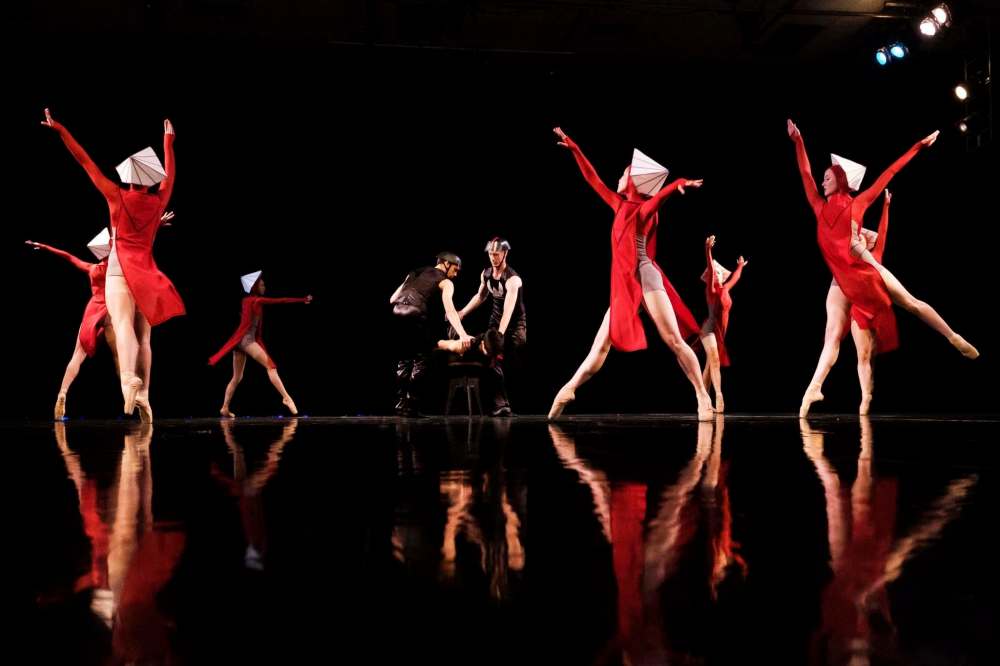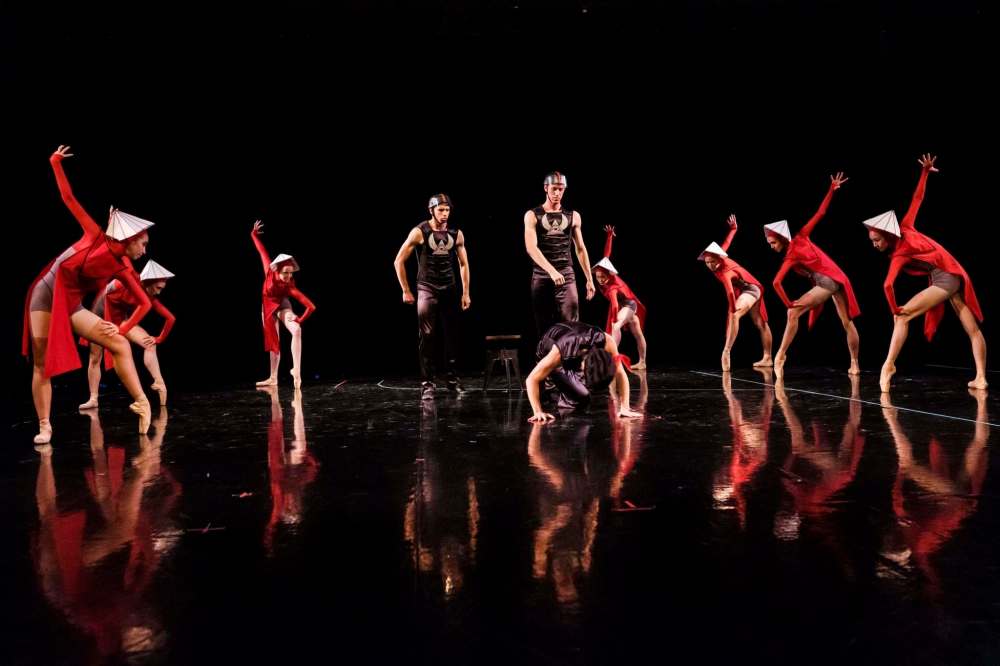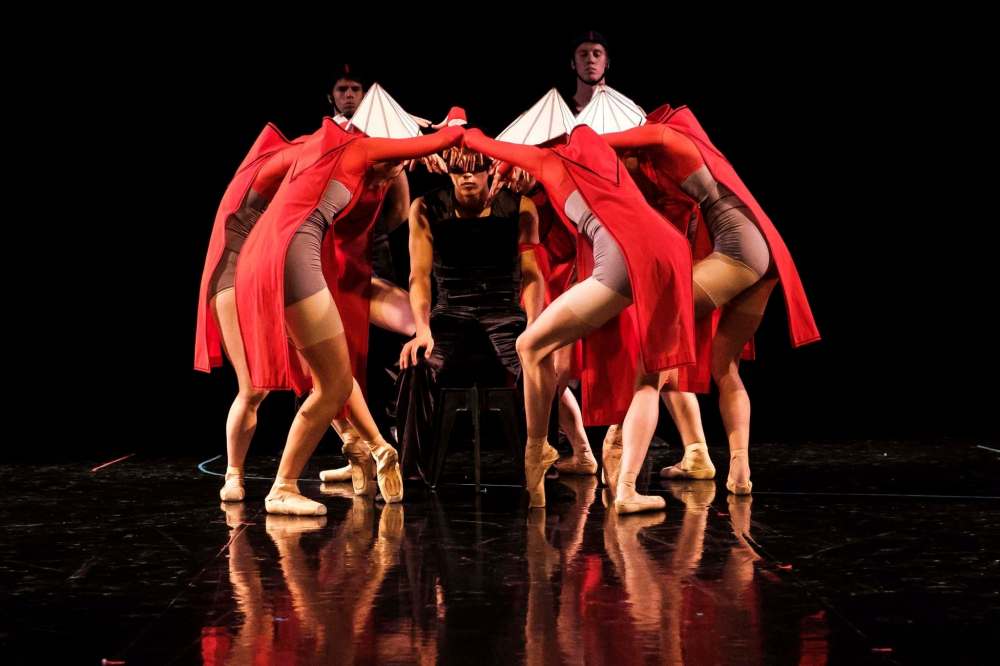A darker shade of red
RWB's The Handmaid's Tale keeps evolving since its debut five years ago
Advertisement
Read this article for free:
or
Already have an account? Log in here »
To continue reading, please subscribe:
Monthly Digital Subscription
$1 per week for 24 weeks*
- Enjoy unlimited reading on winnipegfreepress.com
- Read the E-Edition, our digital replica newspaper
- Access News Break, our award-winning app
- Play interactive puzzles
*Billed as $4.00 plus GST every four weeks. After 24 weeks, price increases to the regular rate of $19.00 plus GST every four weeks. Offer available to new and qualified returning subscribers only. Cancel any time.
Monthly Digital Subscription
$4.75/week*
- Enjoy unlimited reading on winnipegfreepress.com
- Read the E-Edition, our digital replica newspaper
- Access News Break, our award-winning app
- Play interactive puzzles
*Billed as $19 plus GST every four weeks. Cancel any time.
To continue reading, please subscribe:
Add Free Press access to your Brandon Sun subscription for only an additional
$1 for the first 4 weeks*
*Your next subscription payment will increase by $1.00 and you will be charged $16.99 plus GST for four weeks. After four weeks, your payment will increase to $23.99 plus GST every four weeks.
Read unlimited articles for free today:
or
Already have an account? Log in here »
Hey there, time traveller!
This article was published 09/10/2018 (2578 days ago), so information in it may no longer be current.
A lot has happened since the Royal Winnipeg Ballet’s adaptation of The Handmaid’s Tale made its world première five years ago.
Donald Trump became president of the United States. Women marched on Washington. #MeToo became a movement. Planned Parenthood continues to fight for its existence. Women’s bodies continue to be battlegrounds, to borrow a phrase coined by feminist artist Barbara Kruger in 1989 — not long after Margaret Atwood published her prescient novel about a dystopian society in which women have been stripped of their reproductive rights and freedom.The Handmaid’s Tale, meanwhile, also became an Emmy-winning television series.
The week I met with the ballet’s choreographer, Lila York, Brett Kavanaugh, Trump’s Supreme Court nominee, appeared before the U.S. Senate Judiciary Committee and denied the allegations levelled at him by Christine Blasey Ford, who claims he sexually assaulted her when they were in high school. Judge Kavanaugh sits at the confluence of #MeToo and the ongoing fight for hard-won reproductive rights; many believe a Kavanaugh confirmation could result in the gutting — or complete reversal — of Roe v. Wade.“The threat to women’s freedom, right at this moment, is quite real” – Lila York, choreographer for the Royal Winnipeg Ballet presentation of the Handmaid’s Tale

And women are increasingly showing up to protests, including at last week’s Senate hearing, dressed as handmaids — who, in Atwood’s totalitarian Republic of Gilead, are state-appointed concubines who are forced to bear children against their will.
The Handmaid’s Tale isn’t just relevant — it has become a symbol of resistance.
“It’s happening inside the United States right now, as this ballet is going up,” says York, who was born in Syracuse, N.Y., and is based in New York City. “The threat to women’s freedom, right at this moment, is quite real.”
And women’s freedom, she points out, is inextricably linked to unfettered access to reproductive health care, which includes contraception and abortion.
“If women can be readily impregnated, they can’t make choices,” she says. “If there’s no contraception, they can’t make life choices. They can’t go to med school or become lawyers or professors. They can’t realize their full potential. It’s terrifying on so many levels to think that women could lose all of the gains they’ve made in 200 years.”
It makes sense, then, that The Handmaid’s Tale Winnipeggers will see this week is a few shades darker than the version that premièred five years ago. York made some revisions prior to the ballet’s Ottawa tour in 2015, and a few more in the past couple weeks.
“I’m much happier with it now,” she says. “I think it has a little more punch and a little more guts. It still has a hopeful ending, but what’s prior to the hopeful ending is a little tougher than it was. I think that I was holding back because it was a ballet company and I didn’t want to push my luck too far. A modern dance company, I wouldn’t have as many reservations, but with a ballet company I was a little gun shy. The popularity of the television show liberated me to push it further.”

Adapting a novel, especially one as dense as Atwood’s, for the ballet presents unique challenges. The Handmaid’s Tale is told through the lens of the handmaid Offred, and York considered giving her a voiceover as they do in the TV series. Offred is a cerebral character; Elisabeth Moss, who plays Offred in the TV show, not only has a voiceover but is often filmed in extreme closeup.
“So much happens inside her mind, and there’s so much subtlety,” York says. “She does what she has to do to survive. On the surface, she’s very co-operative and obedient, but inside her head she’s cursing. You get to know her real self when you hear the voice of her thoughts. I can’t do that in a ballet.”
Soloist Alanna McAdie was one of the dancers tasked of giving Offred a voice through movement. She will alternate with second soloist Elizabeth Lamont.
“Offred internalizes things,” she says. “She’s thoughtful and intelligent. A lot of what I did to think about the role was film small movements. I wanted to find ways of acting that were big enough to read at the back of the theatre, but also weren’t too overly dramatic because that’s not who she is.” That required some finely detailed work, paying attention to everything from how she moved her shoulders to the tilt of a head. “Even taking a breath can read a certain way. Lila’s great with how she told the story, and the movement quality she brought out in each of the characters is really strong. The movement itself tells the story.”
“The basic storyline is an action story,” York says. “There are events. That’s why I determined I could make a ballet with it.” Working with a smaller company already necessitated a streamlined telling of the story, but York wanted the audience to be able to understand what was happening without having to consult a program. She didn’t want to make her adaptation too abstract.
“If I were going to make a different kind of work, like a modern dance called Offred, I might have judges sitting in black robes with corporate logos on them,” she says. “That’s not Margaret Atwood’s novel. I wanted to take the audience where the novel takes the audience.”
The Handmaid’s Tale is a bold departure for the full-length story ballet.

“A lot of the ballets we present provide an escape from reality,” McAdie says. “In this case, I feel that this is a really powerful story that conjures a lot of emotion and thought,” McAdie says. “It’s a work that’s there to challenge.”
“Story ballets are about fantasy and fairytales,” York says. “They’re very much about straight-shot beauty. This is about substance. I tried to make beautiful sections of the ballet, but it has a lot more meat to it. And that’s not normal in the ballet world; ballet doesn’t usually go to that kind of subject matter. But I think it’s great. It’s great to take ballet into new territory.”
jen.zoratti@freepress.mb.caTwitter: @JenZoratti

Jen Zoratti is a columnist and feature writer working in the Arts & Life department, as well as the author of the weekly newsletter NEXT. A National Newspaper Award finalist for arts and entertainment writing, Jen is a graduate of the Creative Communications program at RRC Polytech and was a music writer before joining the Free Press in 2013. Read more about Jen.
Every piece of reporting Jen produces is reviewed by an editing team before it is posted online or published in print – part of the Free Press‘s tradition, since 1872, of producing reliable independent journalism. Read more about Free Press’s history and mandate, and learn how our newsroom operates.
Our newsroom depends on a growing audience of readers to power our journalism. If you are not a paid reader, please consider becoming a subscriber.
Our newsroom depends on its audience of readers to power our journalism. Thank you for your support.

